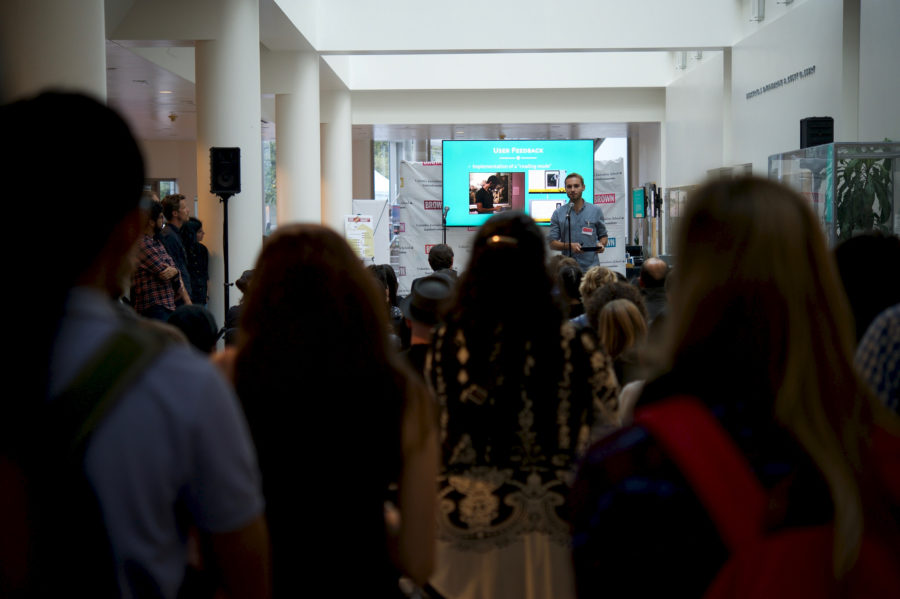More than 200 people turned out for the first annual Brown Institute Media Innovation Showcase last night at Stanford University. The event recognized the innovative work of 12 Magic Grant teams and Brown Fellows from the 2016 cohort who presented and demoed their projects—some for the first time. Read on.
Among the project highlights:
> G-Drone demonstrated a new drone tour guide system that lets people interact with a drone using simple hand gestures. using a simple projected interface. After sunset, Stanford Computer Science PhD graduate Jessica Cauchard took two groups on a walking tour around the engineering quad. G-Drone features a simple projected interface that users to control it with minimal hand movements, and is a look into the future of how we all might interact with drones as they become integrated into our daily lives.
> Art++ demonstrated a groundbreaking augmented reality technology that transforms the museum-going experience by overlaying short stories, panoramas and other bits of information onto paintings using mobile devices. The project recently was featured at a Cantor Art Museum exhibition. Data captured during the show indicate the new technology tripled the average time museum-goers spent viewing works of art.

> Humor Tools uses an algorithm to help people write jokes as funny as those written by the staff at The Onion. By breaking down a particular type of joke featured in the Onion’s ‘American Voices’ section, HumorTools makes language suggestions that can help would-be comedians make boring statements more engaging.
Several Brown Institute teams dedicated their efforts to opening up civic data:
> Open Contractors debuted a new database and dashboard which makes it easier for journalists and other users to search a database of 22 million Department of Defense contracts, allowing for a better understanding of where Americans’ tax dollars go.
> Building off the momentum that started with the Panama Papers expose, the Nueva Nación team built Panama’s first open data portal of government data to expose bad government actors. Reporting off this database, the team published several stories that resulted in protests in the streets of Panama City streets.
> The Science Surveyor team built a tool for science journalists that makes it easier for them to put breaking news studies into context. This tool captures and visualizes the corpus of scientific literature to put new scientific findings into a publication timeline, showing journalists where a study lies in relation to scientific consensus, who funded it and sources a reporter might want to call to get more information.
Other teams showed the power of applying new technology to traditional storytelling. Teams from the Mapping Monuments, On the Brink of Famine and Cuba Interconnectada projects used drones, virtual reality and data visualization techniques to tell stories in new ways. Mapping Monuments premiered spectacular video footage shot using drones that told the story of Spomeniks, epic World War II monuments in the former Yugoslavia that are being abandoned and left to erode.

> On The Brink of Famine, a 360 video documentary of the famine in South Sudan made in partnership with PBS FRONTLINE, showed how virtual reality can not only transport us to places we would never otherwise go, but can be a vehicle for conveying human experiences.
> Cuba Interconectada premiered the first five minutes of their documentary about how the island nation is being transformed by digital networks, both from government-sanctioned wifi hotspots that have been many Cuban’s first telecom connections to the outside world, and through illicit networks, built wirelessly across the island and files traded hand to hand, are reshaping access to culture across the island.In addition, the Showcase included the work of several of The Brown Institute’s Fellows.
> Stanford fellowJuho Kim’s Recipe Tools creates an explorable landscape of the diversity of recipes, mined from the internet. It’s a novel way to look across thousands of people’s wisdom – in this case, how to make cookies – to understand their diversity of ingredients and process. It also leads to deliciousness.
> Stanford fellow Rebecca Weiss presented her ongoing project, The Media Is Biased, a study of media bias across most American news outlets using the Media Cloud project from the Berkman/Klein Center at Harvard and the Center for Civic Media at MIT.
> Columbia fellow Aram Chung presented The Hitchhiker’s Guide to Newsroom Algorithms, an interactive textbook for data journalism she’s spent the past few years building, designed to help teach this emerging discipline with self-directed techniques STEM instruction.
“Watching our projects presented one after the other, it was hard not to feel pride in what our teams have made,” said Mark Hansen, Director of the Brown Institute at Columbia University. “The Brown’s would have been impressed by their creativity, their impact. It was an extraordinary evening.”

